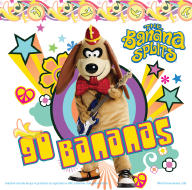The Banana Splits were the brainchild of Joseph Barbera, one half of the famed Hanna-Barbera animation team behind such characters as the Flintstones, the Jetsons, Yogi Bear, and Scooby Doo. In 1967 Barbera was approached by Lee Rich of the Leo Burnett Agency, a Chicago-based advertising firm, to create a program designed as a showcase for Kellogg's, the Battle Creek, MI, breakfast cereal magnate. Rich proposed that Barbera produce an hourlong Saturday morning children's show; Barbera countered that the show should break new ground, and suggested that instead of animated characters, its hosts might be costumed performers resembling giant puppets. Some time later, Barbera outlined his finished proposal to the Burnett staff and Kellogg's representatives, as well as Grant Tinker, an NBC television executive who later became the network's president; to bring his ideas to life, Barbera introduced an actor dressed in a Yogi Bear costume, a move that proved instrumental in selling the series on the spot.
Essentially, the Banana Splits concept was like the Monkees once removed; clearly modeled on the exuberance and slapstick comedy of the Beatles' film #A Hard Day's Night, the show also borrowed heavily from the bright, psychedelic image the Fab Four sported on the cover of Sgt. Pepper's Lonely Hearts Club Band. Like both the Beatles and the Monkees, the Splits were a four-piece pop band, and like the Monkees (and the Beatles in #Help!), they even lived together in the same mod digs. Unlike their human predecessors, however, the Banana Splits were bizarre, anthropomorphic animals: rhythm guitarist Drooper was a lion, lead guitarist Fleegle was a dog, keyboardist Snorky was an elephant, and drummer Bingo was a monkey. The episodes consisted of skits, cartoons, a live-action cliffhanger serial called #Danger Island (directed by Richard Donner, who went on to helm the #Superman and #Lethal Weapon films), and of course, musical performances. In total, some 23 bubblegum tunes were produced for the show; one was even written by soul crooner Barry White. In 1968, Decca issued an LP, We're the Banana Splits, collecting a dozen of the program's performances; the series' theme, The Tra-La-La Song, even reached the Billboard Top 100 singles chart. In addition, Kellogg's issued an eight-song double EP pack, available only through the company for two cereal box tops and 50 cents.
#The Banana Splits was a ratings blockbuster during the 1968-1969 television season, drawing an incredible 65 percent share of the Saturday morning audience. The second season, however, proved disastrous: while the Hanna-Barbera production staff filmed all new episodes, they did so without changing the backgrounds or any of the set designs, prompting young viewers to mistakenly believe that the new segments were actually reruns. Consequently, ratings plummeted, and #The Banana Splits was unceremoniously axed in 1970. The show went largely forgotten for much of the decade, but in the 1980s a resurgence began; first punk satirists the Dickies covered The Tra-La-La Song, and then no less a figure than R.E.M. frontman Michael Stipe declared the Banana Splits a bigger influence on his work than even the Beatles. In the 1990s, the revival exploded: the acclaimed singer Liz Phair recorded her own rendition of The Tra-La-La Song for a tribute collection of Saturday morning themes, and more importantly, the original #Banana Splits episodes went into heavy rotation on cable's Cartoon Network for an entirely new generation of viewers to enjoy. ~ Jason Ankeny, Rovi

















